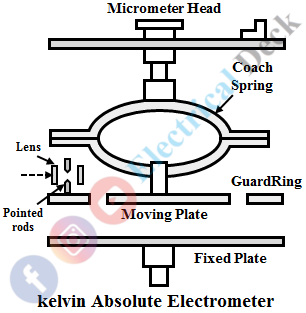An attracted disc type electrostatic instrument is basically known as a portable electrostatic instrument. This device contains two semicircular plates one being stationary and the other rotating. Both the plates are electrically insulated from each other.
The unknown voltage to be measured is applied across the plates, which results in the development of an electrostatic field between the plates. The electrostatic field developed is attractive in nature. The below shows the portable electrostatic instrument.
Due to the electrostatic force of attraction, the moving plate gets attracted towards the stationary plate and gets deflected. The control spring fixed to the rotating plate provides the required controlling torque and the air friction provides the necessary damping.
Kelvin Absolute Electrometer :
Kelvin's absolute electrometer is an attracted disc type electrostatic voltmeter.
Construction of Kelvin Absolute Electrometer :
The essential parts of kelvin absolute electrometer are,- Fixed plate or disc
- moving plate or disc
- Coach spring
- Guard ring
- Micrometer head.
In the above figure, the moving disc is suspended by a micrometer head with the help of a coach spring in a way such that it comes exactly at the center of the fixed plate or disc. This movable disc is surrounded by a guard ring, which is electrically in contact with it.
A small gap is maintained between the guard ring and the moving plate. The main function of the guard ring is to reduce the fringing effect. Lenses and finely pointed rod are also used, in order to set the moveable plate to zero setting.
Working of Kelvin Absolute Electrometer :
A voltage that is to be measured is applied between the two plates. When a potential difference is applied between the plates then the moving plate will be attracted towards the fixed plate. But by rotating the micrometer head the moveable plate can be brought back to its original location. A micrometer which is calibrated in terms of force is used to measure the displacement of the moving plate.
In order to get the best result, the calibration must be done in a proper way. When calibrating the instrument, initially the instrument is short-circuited, and also the moveable plate is set to its original location i.e., at zero position.
Then the known weights are added to the plate, and then the moment of micrometer required to bring back the moveable plate to its original locations are noted for various known weights. Thus the voltage obtained will be in terms of the fundamental units of force, length, and area.






